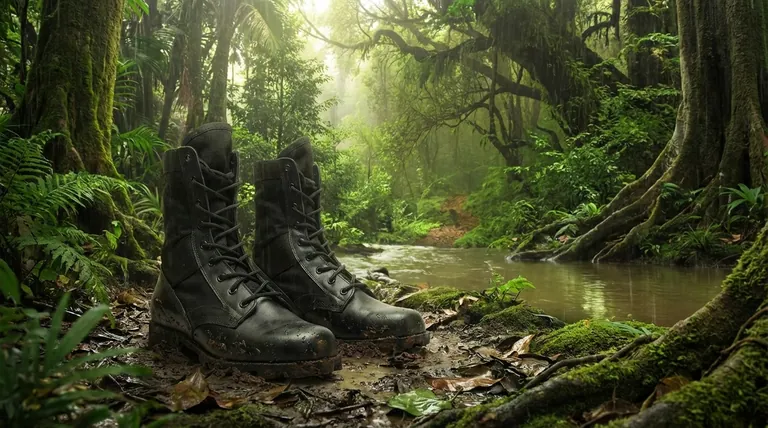During the Second World War, the M-1942 jungle boot was a specialized piece of equipment used by US military personnel fighting in the harsh tropical environments of the Pacific Theater. Deployed in locations like New Guinea, the Philippines, and Burma, these boots were issued to elite units such as Merrill's Marauders and the 1st Air Commando Group to combat the debilitating effects of constant moisture and heat.
The core innovation of the WWII jungle boot was not its ability to keep water out, but its capacity to let water escape. This design philosophy accepted the inevitability of wet feet in the jungle, prioritizing rapid drainage and ventilation to prevent the severe foot infections that plagued soldiers in standard leather boots.

The Problem with Standard-Issue Boots
Failure in the Jungle
Standard-issue military boots of the era were made of thick leather. While durable on European battlefields, they were a liability in the tropics.
Once saturated in jungle swamps or torrential downpours, leather boots would retain water, become incredibly heavy, and fail to dry. This created a perfect environment for fungal infections and immersion foot (trench foot), which could incapacitate a soldier as effectively as a combat wound.
The M-1942: A New Design Philosophy
Built for Drainage, Not Waterproofing
The jungle boot, developed as early as 1942 in conjunction with the U.S. Rubber Company, was a radical departure from traditional footwear.
The design featured a rubber sole and a lightweight canvas upper. The core principle was that no boot could realistically keep water out while also providing enough ventilation. Therefore, the M-1942 was designed to let water drain out and allow the boot to dry as quickly as possible, protecting the soldier's feet.
Key Theaters of Operation
These boots were not general issue. They were specifically deployed to units operating in the most demanding jungle and swamp environments of the war.
Their use was concentrated in the Pacific Theater, seeing action in the campaigns for New Guinea, the Philippines, and the China-Burma-India Theater.
Understanding the Trade-offs
Durability vs. Performance
The lightweight canvas and rubber construction that made the jungle boot so effective in wet conditions also made it far less durable than standard leather field shoes.
The boots wore out quickly on rough terrain, which limited their widespread application.
Use as Secondary Footwear
Because of their poor durability, soldiers often did not wear jungle boots as their primary footwear.
Instead, they were frequently carried as a backup pair. Troops would switch into their jungle boots specifically to navigate soft mud or cross streams, preserving their more durable leather boots for harder ground.
Context: A War of Specialized Footwear
The Right Boot for the Right Environment
The M-1942 jungle boot was part of a broader trend during WWII toward developing environment-specific equipment.
Boots for Sand and Flood
For example, British forces fighting in the deserts of North Africa wore lightweight suede chukka boots, modified with crepe rubber soles for better traction in sand.
Similarly, soldiers in the flooded lowlands of the Netherlands were supplied with Wellington and thigh-high rubber boots to operate in inundated conditions. This demonstrates a growing understanding that standard equipment was insufficient for global warfare.
Key Takeaways from the Jungle Boot's Role
The development and deployment of the M-1942 jungle boot provide a clear lesson in military adaptation.
- If your primary focus is on military innovation: The jungle boot represents a critical shift from a "one-size-fits-all" equipment philosophy to highly specialized, environment-specific design.
- If your primary focus is on battlefield survival: The boot's design proves that sometimes accepting an environmental challenge (water getting in) and mitigating its effects is more effective than trying to prevent it entirely.
- If your primary focus is on equipment trade-offs: The M-1942's limited durability highlights the constant balance engineers must strike between specialized performance and the need for long-term reliability.
Ultimately, the WWII jungle boot was a crucial adaptation that demonstrated a simple truth: victory often depends on conquering the environment itself.
Summary Table:
| Aspect | WWII Jungle Boot (M-1942) |
|---|---|
| Primary Use | Specialized footwear for tropical environments in the Pacific Theater |
| Key Design Feature | Canvas upper and rubber sole for rapid drainage and ventilation |
| Main Advantage | Prevented immersion foot by allowing water to escape quickly |
| Key Limitation | Lower durability compared to standard leather boots |
| Typical Users | Elite units like Merrill's Marauders in New Guinea, Philippines, and Burma |
Need Specialized Footwear for Demanding Environments?
As a large-scale manufacturer, 3515 produces a comprehensive range of specialized footwear for distributors, brand owners, and bulk clients. Our production capabilities encompass all types of shoes and boots, designed to meet specific environmental and performance needs—just like the innovative jungle boots of WWII.
Let us help you conquer your terrain. Contact us today to discuss your footwear requirements!
Visual Guide

Related Products
- Durable Military Combat Boots with Water Drainage for Wholesale & OEM
- Durable Leather Tactical Boots Wholesale & Custom Manufacturing for Brands
- Wholesale Waterproof Tactical Boots Custom Suede & High-Traction Soles
- Durable Mid-Cut Tactical Boots for Wholesale & Private Label
- Wholesale Lightweight Tactical Boots with Dial Closure OEM & Bulk Orders
People Also Ask
- How did combat boots transition from military use to popular culture? From Battlefield to Fashion Statement
- How do luxurious ostrich leather shoes differ from traditional dress shoes? A Guide to Texture & Comfort
- What replaced jungle boots in the US military? The Shift to Tan Suede Combat Boots
- How can a shiny finish be achieved on military boots? A Step-by-Step Guide to a Mirror Shine
- What are military boots designed for? Unmatched Durability & Protection for Extreme Conditions



















